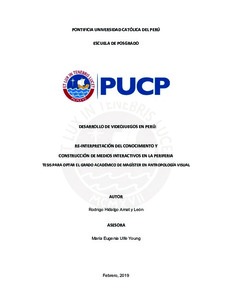| dc.contributor.advisor | Ulfe Young, María Eugenia | |
| dc.contributor.author | Hidalgo Amat y León, Rodrigo | es_ES |
| dc.date.accessioned | 2019-08-29T00:37:31Z | es_ES |
| dc.date.available | 2019-08-29T00:37:31Z | |
| dc.date.available | 2019-08-29T00:37:31Z | es_ES |
| dc.date.created | 2019-02 | es_ES |
| dc.date.issued | 2019-08-28 | es_ES |
| dc.identifier.uri | http://hdl.handle.net/20.500.12404/14846 | |
| dc.description.abstract | ¿Qué significa hacer videojuegos "como en Perú”? ¿Significa crear mecánicas de juegos
distintas? ¿plantear procesos? ¿Representar nuestras historias? Este trabajo analiza la
mirada e inquietudes de los desarrolladores de videojuegos de Perú, un territorio
considerado como emergente en la industria. Nos concentramos en las interacciones
sociales en las que se forjan los criterios estéticos de los videojuegos peruanos. Desde la
etnografía, identificamos el rol y la importancia que tiene la localidad, las comunidades
online y los recursos tecnológicos disponibles, tanto en el diseño como en el desarrollo
de un videojuego. Así, conocer flujos de trabajo y la identidad profesional de estos
desarrolladores, nos pueden acercarnos a la construcción visual, el diseño e historias que
caracterizan a un videojuego desarrollado en Perú. Para muchos jóvenes los videojuegos
representan la entrada a mundos sociales donde pueden conectarse con personas e
identificarse con diversos grupos. Alrededor de la actividad del “play” existe un medio
intelectual paralelo donde sus participantes no solo consumen medios sino, crean una
producción cultural bastante rica. Consecuencia de esto es que encontramos streams,
foros, blogs y comunidades online dedicadas a juegos. Es decir, un medio intelectual con
ambiente propicio para la formación de las primeras comunidades de desarrolladores en
los territorios emergentes. Y con producción cultural que se convierte en un referente
bastante marcado en los posteriores juegos desarrollados. Los desarrolladores habitan
diversos mundos sociales a la vez, tanto como jugadores como profesionales. Las
dinámicas de poder en estos grupos y prácticas tienen influencia sobre sus videojuegos.
Los videojuegos peruanos independientes tienen características familiares, si bien no se
tratan de reskins de juegos, usualmente remezclan mecánicas de juegos ya existentes. La
mayoría de desarrolladores peruanos usan herramientas abiertas. El estilo de arte
privilegia el ahorro de recursos y tiene como fuerte influencia estilos usuales dentro de la
cultura geek. | es_ES |
| dc.description.abstract | What does it mean to make videogames “as in Peru?” Does it mean creating different
game mechanics? To implement new processes, to represent our stories? This work
analyzes the look and concerns of the video game developers of Peru, a territory
considered as emerging in the industry. We focus on the social interactions in which the
aesthetic criteria of Peruvian videogames are forged. From ethnography, we identify the
role and importance of the locality, the online communities and the available
technological resources, both in the design and in the development of a videogame. Thus,
knowing the workflows and the professional identity of these developers, can bring us
closer to understand the visual construction, design and stories that characterize a video
game developed in Peru. For many young people, video games represent the entrance to
social worlds where they can connect with people and identify with different groups.
Around the activity of “play” there is a parallel intellectual environment where its
participants not only consume media but also create a rich cultural production.
Consequence of this is that we find streams, forums, blogs and online communities
devoted to games. An intellectual medium that enables an advantageous climate for the
formation of game developer communities in the emerging territories. And with that also
comes cultural production that turns into a benchmark in the subsequent games will
be developed in the territory. The developers inhabit diverse social worlds both as players
and professionals. The dynamics of power in these groups and practices influence their
videogames. Independent Peruvian video games have familiar characteristics, although
they are not game reskins, they usually remix existing game mechanics. Most Peruvian
developers use open tools. The style of art privileges the saving of resources and has as
strong influence usual styles within the geek culture. | es_ES |
| dc.language.iso | spa | es_ES |
| dc.publisher | Pontificia Universidad Católica del Perú | es_ES |
| dc.rights | info:eu-repo/semantics/openAccess | es_ES |
| dc.rights.uri | http://creativecommons.org/licenses/by/2.5/pe/ | * |
| dc.subject | Videojuegos--Perú | es_ES |
| dc.subject | Interacción social--Perú | es_ES |
| dc.subject | Medios digitales--Aspectos culturales--Perú | es_ES |
| dc.subject | Geeks (Entusiastas de la informática)--Perú | es_ES |
| dc.title | Desarrollo de videojuegos en Perú : re-interpretación del conocimiento y construcción de medios interactivos en la periferia | es_ES |
| dc.type | info:eu-repo/semantics/masterThesis | es_ES |
| thesis.degree.name | Magíster en Antropología Visual | es_ES |
| thesis.degree.level | Maestría | es_ES |
| thesis.degree.grantor | Pontificia Universidad Católica del Perú. Escuela de Posgrado | es_ES |
| thesis.degree.discipline | Antropología Visual | es_ES |
| renati.advisor.dni | 07871124 | |
| renati.advisor.orcid | https://orcid.org/0000-0002-2749-1036 | es_ES |
| renati.discipline | 315117 | es_ES |
| renati.level | https://purl.org/pe-repo/renati/level#maestro | es_ES |
| renati.type | http://purl.org/pe-repo/renati/type#tesis | es_ES |
| dc.publisher.country | PE | es_ES |
| dc.subject.ocde | https://purl.org/pe-repo/ocde/ford#5.04.03 | es_ES |






